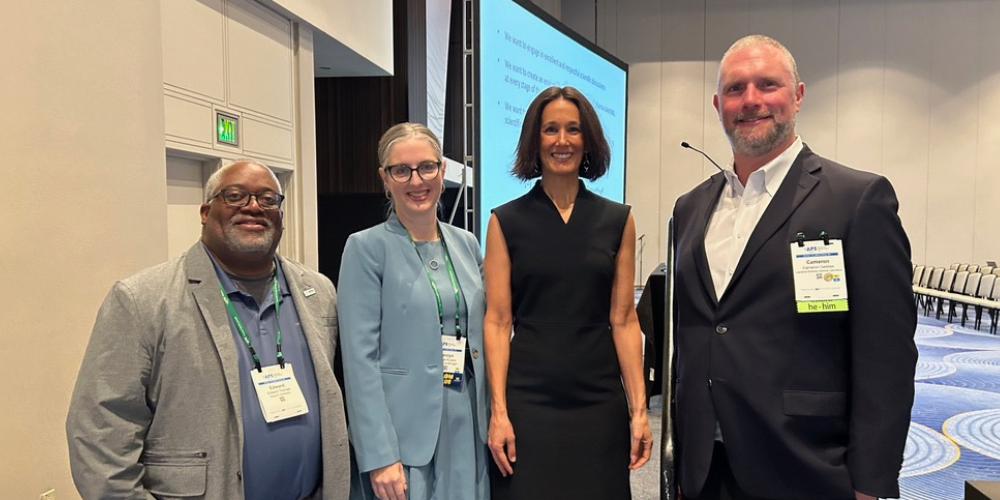Resources
Resources
LaserNetUS Facility Heads Lead APS Division of Plasma Physics
May 7, 2025. News

Current DPP Leaders, left to right: Past Chair Edward E. Thomas, Jr. (Auburn University); Chair-Elect Carolyn Kuranz; Vice Chair Félicie Albert; and Chair Cameron Geddes.
SAN FRANCISCO, CA—As the LaserNetUS initiative continues to emphasize excellence in plasma science, we are thrilled to announce that three of our Facility Points of Contact —Cameron Geddes, Carolyn Kuranz, and Félicie Albert—are serving terms in prominent leadership roles within the American Physical Society (APS) Division of Plasma Physics this year.
- Current Chair Cameron Geddes (Lawrence Berkeley National Laboratory) will transition to Past Chair in October 2025 after completing his FY25 term.
- Current Chair-Elect Carolyn Kuranz (University of Michigan) will take on the role of Chair in October 2025 for FY26.
- Current Vice Chair Félicie Albert (Lawrence Livermore National Laboratory) has been elected Chair-Elect for FY26 and will step into the Chair position in October 2026 for FY27.
This powerhouse trio exemplifies LaserNetUS's commitment to furthering cutting-edge research in laser-driven plasmas and promoting cooperative efforts across the plasma physics community.
In their respective roles, they will preside over the 67th Annual Meeting of the APS Division of Plasma Physics (DPP), held in Long Beach, California, from November 17–21, 2025. This meeting will serve as a vibrant platform for plasma physicists to share their research, network with peers, and partner on efforts that push the field's boundaries.
The three leaders note that nominations are now open for invited talks and tutorials for the meeting. They encourage submissions from the community, as this is an excellent opportunity for researchers to showcase their work and contribute to gains in plasma physics. The deadline for nominations has been extended until Monday, May 12, 2025, 11:59 pm Eastern Time.
At LaserNetUS, we fully support Geddes, Kuranz, and Albert's vision and efforts. Their guidance represents a momentous step forward in promoting innovation, enhancing research output, and elevating the global stature of plasma physics.
"This year, we plan to spearhead initiatives that enhance the visibility and impact of plasma physics research,” said Kuranz. “Our objective is to unite the plasma physics community around the critical applications of plasmas, from everyday technologies to state-of-the-art scientific exploration."
Prof. Kuranz's recent involvement in co-authoring a position paper titled "Plasma Science and Engineering: A Foundational Asset for National and Economic Security” underscores this commitment to strengthening the U.S. plasma physics community. The work highlights the vital role of plasma science in driving technological growth that underpins the economic vitality and national security of the United States.
“Together, we are committed to harnessing the expertise and ingenuity of our community to make significant strides in plasma research,” said Geddes. “Collaboration among plasma physicists is essential for addressing the challenges facing our field and achieving world-changing research outcomes, including a path towards fusion energy.”
Albert shares her enthusiasm: “I am honored to step into this leadership role and look forward to working with the community to further the frontiers of plasma science. Together, we will uphold an environment that stimulates innovative research and breakthroughs.”
We at LaserNetUS extend our heartfelt congratulations to Cameron, Carolyn, and Félicie on their distinguished roles in the APS Division of Plasma Physics. We have complete confidence in their ability to propel meaningful progress for U.S. plasma physicists and elevate the prominence of plasma physics research globally.
For more information about LaserNetUS and ongoing projects or to connect with us, please visit www.lasernetus.org.
About LaserNetUS
LaserNetUS is a collaborative network, supported by DOE Fusion Energy Sciences, dedicated to advancing laser-based research in plasma physics. By uniting various institutions and scientists, we aim to foster innovation and application development that can lead to real-world solutions and a deeper understanding of our universe.
More From News